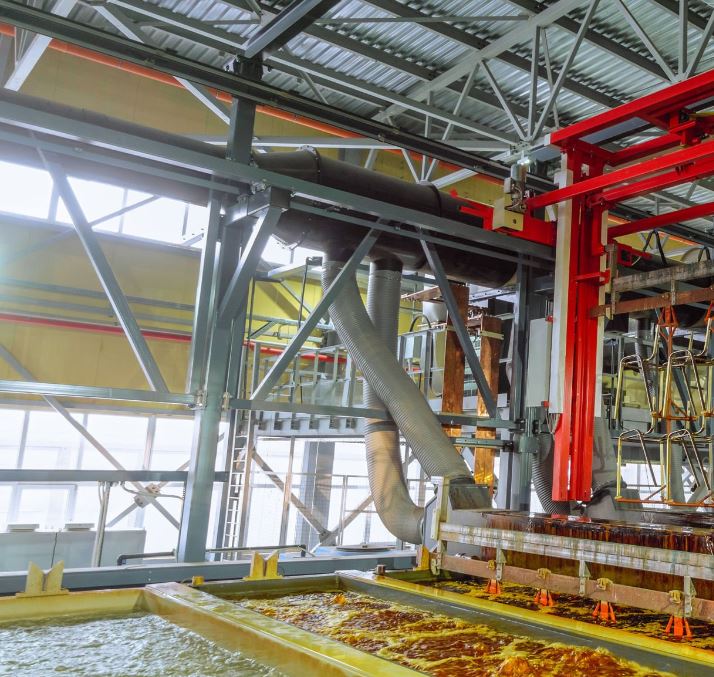Introduction
Dubai, a hub of technological advancements, often relies on state-of-the-art surface finishing techniques for various industrial applications. Two prominent methods in the spotlight are electroless nickel plating and electrolytic nickel plating. Understanding their differences and applications is crucial for making informed decisions in the dynamic landscape of metal finishing.
Electroless Nickel Plating
In the world of surface finishing, electroless nickel plating stands out as a process that doesn’t rely on an electric current. The method involves an autocatalytic reaction, ensuring a uniform coating on complex geometries, which is a game-changer for intricate components. This process boasts advantages like corrosion resistance and versatility, making it a preferred choice in industries where consistency is paramount.
Advantages of Electroless Nickel Plating
1. Uniform Coating: Unlike electrolytic plating, electroless nickel plating ensures an even coat on all surfaces, including recesses and cavities.
2. Corrosion Resistance: The corrosion-resistant properties make it ideal for components exposed to harsh environments.
3. Complex Geometries: Its ability to coat intricate shapes makes it suitable for industries with intricate component designs.

Electroless nickel plating vs Electrolytic nickel plating in Dubai
Applications in Various Industries
Electroless nickel plating finds extensive use in aerospace, automotive, and electronics industries. Its versatility and corrosion resistance make it indispensable for components that demand longevity and reliability.
Electrolytic Nickel Plating
In contrast, electrolytic nickel plating relies on an electric current to deposit nickel onto the substrate. This process offers advantages like high adhesion and a bright finish, making it a preferred choice for applications where aesthetics matter.
Advantages of Electrolytic Nickel Plating
1. High Adhesion: The electroplating process ensures strong adhesion to the substrate, providing durability in challenging conditions.
2. Bright Finish: Electrolytic nickel plating results in a shiny and appealing surface finish.
3. Cost-Effectiveness: It is often more cost-effective for large-scale production compared to electroless plating.
Applications in Different Scenarios
Electrolytic nickel plating is commonly used in industries such as jewelry, plumbing, and decorative applications where a visually pleasing finish is essential.
Differences Between Electroless and Electrolytic Nickel Plating
Understanding the nuances between these two methods is crucial for choosing the right one for a specific application.
Process Variations: Electroless nickel plating is an autocatalytic process, while electrolytic nickel plating relies on an external power source. The absence of electricity in electroless plating allows for a more even coating on complex shapes.
Thickness Control: Electrolytic plating allows for more precise control over coating thickness, making it suitable for applications where exact specifications are critical.
Cost Factors: While electroless nickel plating may have a higher initial cost, the uniform coating and corrosion resistance can lead to long-term cost savings by reducing maintenance and replacement expenses.
Suitability for Specific Applications: The choice between electroless and electrolytic nickel plating depends on the specific needs of the project. Electroless plating is favored for complex geometries, while electrolytic plating is chosen for its precise control and cost-effectiveness.
Choosing the Right Method for Your Needs:
When deciding between electroless and electrolytic nickel plating, several factors must be considered.
Consideration of Project Requirements: Understanding the project’s specifications, including the type of substrate, required coating thickness, and environmental conditions, is crucial for making an informed decision.
Environmental Factors: Considering the environmental impact is essential. Electroless plating, being more eco-friendly, might be preferable for projects with stringent environmental regulations.
Cost Analysis: Conducting a thorough cost analysis, including initial investment and long-term maintenance costs, is vital for selecting the most economical option.
Case Studies:
Examining real-world applications can provide insights into the effectiveness of both methods.
Successful Implementations of Electroless Nickel Plating: In the aerospace industry, electroless nickel plating has been instrumental in enhancing the durability of components subjected to extreme conditions. The uniform coating ensures consistent performance.
Instances Where Electrolytic Nickel Plating Prevailed: In the jewelry industry, electrolytic nickel plating has been widely adopted for its ability to produce a brilliant, aesthetically pleasing finish. The cost-effectiveness of the process makes it a preferred choice for mass production.
Future Trends in Nickel Plating Technologies
As technology evolves, so do surface finishing methods.
Innovations in Electroless Nickel Plating
Ongoing research is focused on improving the efficiency and environmental impact of electroless nickel plating. Innovations in the chemistry of plating solutions aim to enhance performance and reduce waste.
Advancements in Electrolytic Nickel Plating
Advancements in electrolytic nickel plating are geared towards achieving higher efficiency and reducing energy consumption. These improvements aim to make electrolytic plating more sustainable and cost-effective.
Environmental Impact
As industries are urged to adopt more sustainable practices, evaluating the environmental impact of nickel plating methods is crucial.
Comparison of Environmental Footprints
Electroless nickel plating, being a chemical process without the need for an external power source, generally has a lower environmental impact compared to electrolytic plating.
Sustainable Practices in Nickel Plating
Adopting sustainable practices, such as recycling plating solutions and optimizing water usage, can mitigate the environmental impact of both electroless and electrolytic nickel plating.
Quality Standards and Regulations in Dubai
Ensuring compliance with local regulations and industry standards is imperative for businesses in Dubai.
Compliance Requirements
Businesses engaged in nickel plating must adhere to regulations set by authorities in Dubai. Compliance ensures the safety of workers and the community.
Industry Standards
Adhering to international industry standards guarantees the quality and reliability of nickel-plated products. Certifications such as ISO standards are essential benchmarks for businesses in Dubai.
Conclusion
In the realm of electroless nickel plating vs. electrolytic nickel plating, there is no one-size-fits-all solution. Each method has its merits, and the right choice depends on the specific requirements of the project. Electroless plating offers uniformity and corrosion resistance, ideal for challenging geometries, while electrolytic plating excels in cost-effectiveness and bright finishes. The future promises continued innovations in both technologies, contributing to more sustainable and efficient surface finishing solutions.
#Frequently Asked Questions (FAQs)
Q: Which method is better for corrosion resistance?
A: Electroless nickel plating is renowned for its superior corrosion resistance, making it a preferred choice for components exposed to harsh environmental conditions.
Q: Is one method more environmentally friendly than the other?
A: Generally, electroless nickel plating is considered more environmentally friendly due to its chemical process that doesn’t require an external power source.
Q: Are there notable cost differences between electroless and electrolytic nickel plating?
A: While electroless nickel plating may have a higher initial cost, it can lead to long-term cost savings through reduced maintenance and replacement expenses.
Q: Can both methods be used for the same application?
A: The choice between electroless and electrolytic nickel plating depends on specific project requirements. In some cases, they may be interchangeable, but considerations like geometry and cost play a crucial role.
Q: What advancements can we expect in nickel plating technologies?
A: Ongoing research aims to improve efficiency, reduce environmental impact, and enhance the overall performance of both electroless and electrolytic nickel plating technologies.
